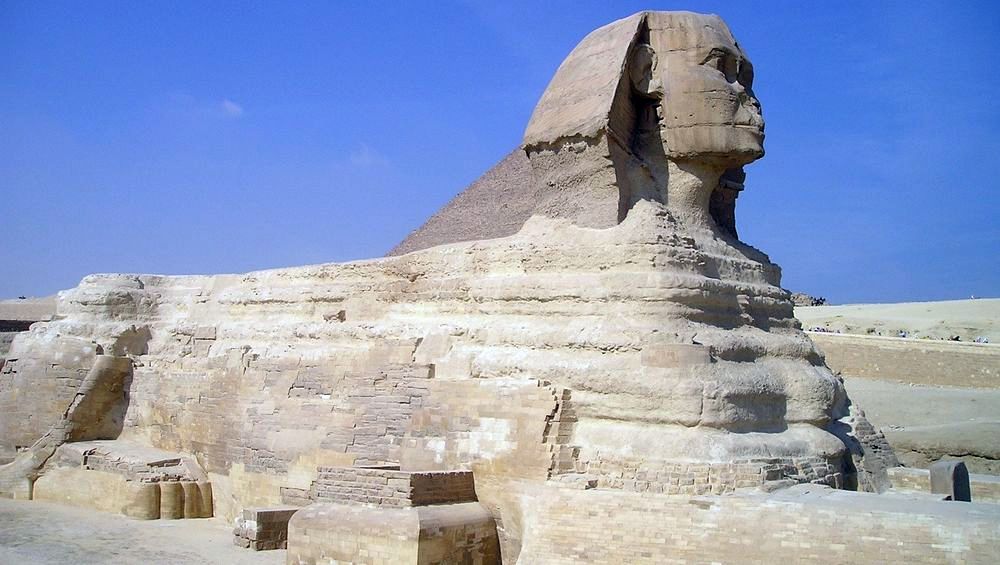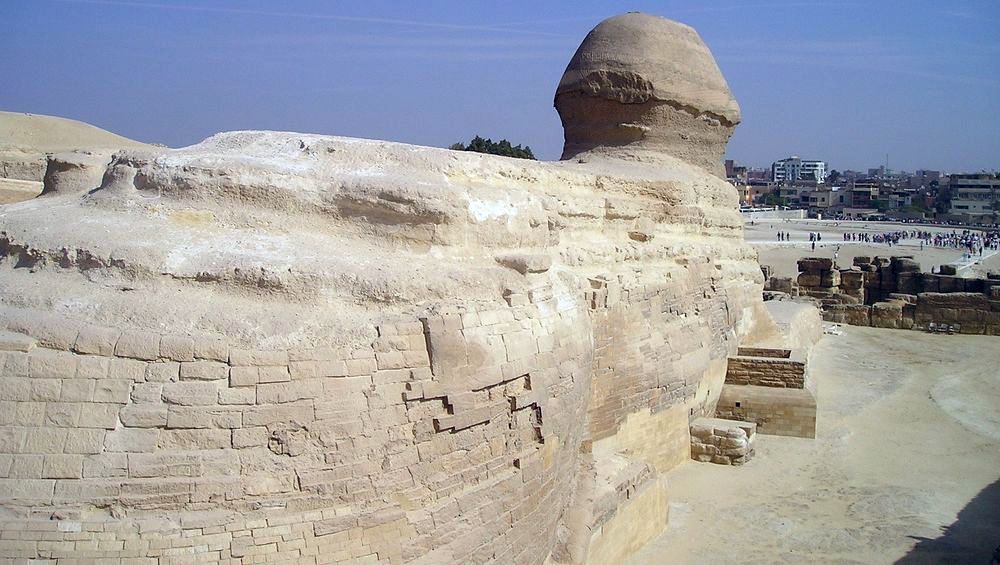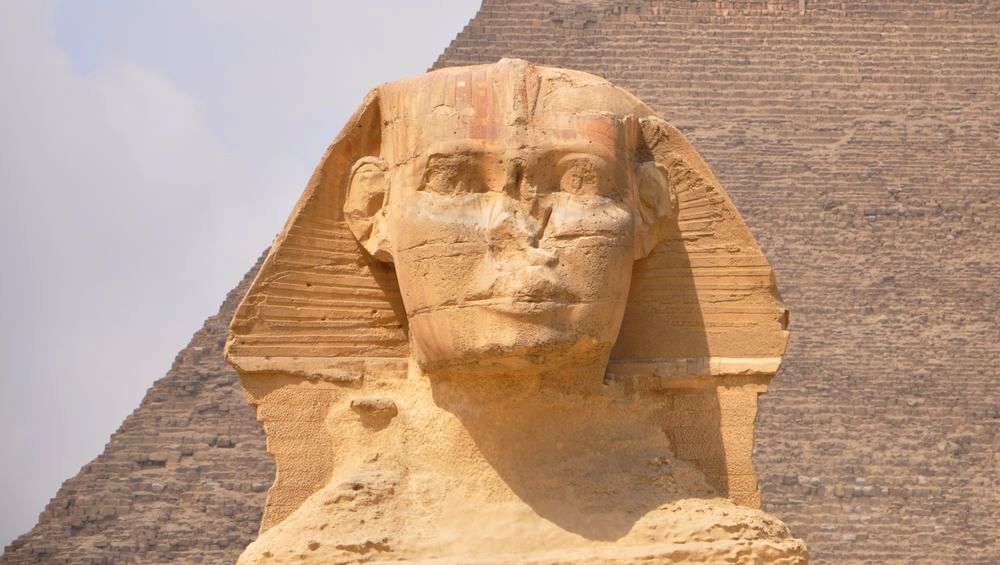The Great Sphinx is a monumental statue located on the Giza plateau, 450m southeast of the Great Pyramid of Khafra. She represents a lion with a human head.
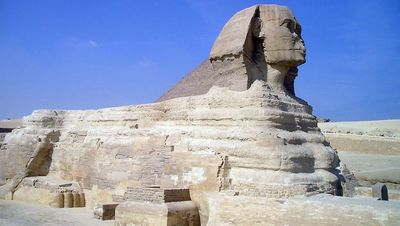
The great Sphinx of Egypt
Description
The Giza Sphinx is really gigantic. It measures exactly 73m50 long and 14m wide and for a height of exactly 20m22. As such it is one of the highest statues in the world, although in the last of the list. Just his head is 5m20, it is almost the same size as the statue of Liberty, which is 5m26. But the mouth of the Sphinx is 2m32 while that of the Statue of Liberty is "only" 91cm! Estimates tend to show that it weighs in at 20,000 tons, but that is questionable, of course, no one has really weighed it.
The Sphinx represents a lion with a man's head. This zoomorphic representation is fairly classic, it is found in almost all civilizations, especially in early civilizations, especially in ancient Egypt. If we look at the statue, we see that the head is smaller than it should be in relation to the body, it is actually wanted. The proportions of the statue are the true proportions of a lion's body and a human head, while for harmony, it would have been necessary to enlarge the head a little to make it look the right size. There was therefore a concern for realism during the sculpture.
The statue consists of several elements. The body and head are cut directly into the rock of a limestone promontory, the front legs are masonry, and the whole was once covered with a kind of painted plaster.
The head is carved from a boulder that protruded from the promontory. The body was carved little by little, with the digging of the rock. Descending in depth the workers discovered that the soil concealed different strata of limestone, forming different colors in the body, but especially different solidities of the rock. This explains why today the body of the Sphinx is striated horizontally, it is the different layers of limestone that have eroded at different speeds. The legs were added afterwards, we do not know why they were not carved at the same time. They are made of limestone blocks of modest size (compared to those used for the construction of nearby pyramids), cut to fit the desired shape. The whole was covered with plaster and painted red, including the face. The menes had to be painted yellow and blue. The Sphinx also has an uræus.
- The menes is the traditional headdress of the pharaohs
- The uræus is a female cobra protecting the pharaoh, it is often found in representation on their foreheads.
There is a curiosity on the head of the Sphinx: A square opening, rather a cavity for that matter. We do not know its function, but some imagine that it was intended to fix on the skull a crown. This cavity no longer exists today, it was closed in contemporary times by concrete.
Face
The face of the Sphinx is heavily damaged, as is easily seen. His nose was deliberately destroyed, it is not a natural degradation. If tradition has it that it was due to the gunners of the army of Bonaparte, during the nineteenth century, these voluntary degradation are in fact Arab Mamluks who used this face as a target.
The reinforcements
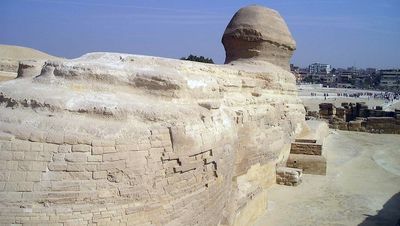
Rear view of the Sphinx
The statue is reinforced by four masonry supports that are on both sides of her body, but it is the only help she has to stand. It must be said that this statue is rather massive, she does not need anything else for that.
Representation and constructor
It is interesting to ask the question to know who is represented by the Sphinx, and who built it. This question is fundamental, but no one has answered it so far. All the specialists can do is suppositions. What is certain is that it was built during the IVth Dynasty, around the XXVII century BC.
Two arguments tend to prove that the Sphinx represents Khafra. First of all the lower temple of his funeral complex is very similar to that of the Sphinx, they could both have been built by the same architect. In addition, they are both side by side, with the same dimensions. The second argument lies in the resemblance between the facial features of the Sphinx and those of Khafra, which can be seen on certain statues, particularly the magnificent diorite statue now on display in the Cairo Museum. The problem with this argument is that it is subjective and that everyone does not agree with this resemblance.
The German Egyptologist Rainer Stadelman proposes that the Sphinx was built by Khufu. It is based on the deviation of the pavement of the Khufu complex, which could have been caused by the presence of the Sphinx during its construction, which would then be anterior to the Khafra complex. And he considers that the likeness between the Sphinx is Khafra and less than between the Sphinx and Khufu.
The Egyptologist Vassil Dobrev thinks that the Sphinx was built by Djedfrê and that he represents his father, it would be a homage statue.
We must then know that the wearing of the false beard appeared only under Khafra, previously we had not yet invented this originality. But the Sphinx does not have a false beard. Does this mean that the Sphinx is before it, or that it was carved before Khafra decided to wear one? And another argument, just to complicate everything, the oldest representations of Pharaohs in Sphinx date from Djedefrê, the eldest son of Khufu, predecessor of Khafra. So either this statement is false, or the Sphinx is later than this Pharaoh.
So in the end, we still do not know who the Sphinx is and who he represents, although Khafra is a good candidate.
Orientation
From the orientation point of view, the Sphinx looks full East, and this very precisely. When the sun rises on the day of the equinoxes it is perfectly aligned with the temple and the gaze of the Sphinx.
Purpose
What was the Sphinx for?
Here too, we do not know anything about it, the specialists do not have enough material to affirm it. He seems to be a guardian of the Giza necropolis, since the Sphinx, from a general point of view, are guardians. This is also why we find them in front of the doors, the entrances, often in pairs, one on each side. Or, they are arranged along a long driveway.
silting
The silting is a natural phenomenon against which it is necessary to fight permanently. Indeed, being dug in the rock, the Sphinx is surrounded, at least partially, rock walls that block the sand brought by the desert winds. Untreated, this sand stagnates and sands the statue little by little, to the point of seeing only the head. It's hard to believe nowadays, but she spent more time under the sand than in her natural state.
It is known that during the 17th Dynasty the Sphinx was silted, it probably remained until the beginning of the 1st century BC, during which time Tiberius Claudius Balbilus, governor of the Roman province of Egypt, ordered its desensitization. When finished, he built an altar nearby.
The pharaoh Thutmosis IV had already made the Sphinx desolate, and to prevent it from being re-erected, he erected around several walls of raw brick plaster coated with a height of 9 meters, but he there is almost nothing left of these really old walls.
Degradation and restorations
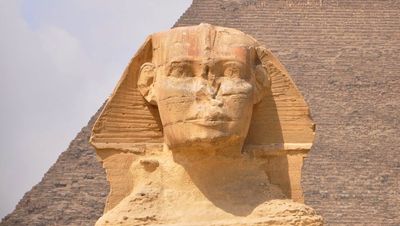
The face of the Sphinx of Egypt
As the Sphinx was dug into a rock with several layers of different hardness, the erosion was not the same from one part of his body to another. The body is thus streaked with horizontal digs that alternate with stone advances. Erosion is really the main source of natural degradation of the Sphinx. There is another, the wear of time. Indeed the time passing pieces of rocks were detached from the body of the Sphinx, forming holes that had to be plugged to prevent the collapse of the entire structure. Hence the need for regular renovations.
The first major restoration took place during the XXVIth Dynasty (664 to 525 BC) under Tuthmosis IV, it consisted of replacing the fallen stones with masonry. A second important restoration took place during the Greco-Roman period (332 BC to 395 AD), during which blocks were replaced again. Other restorations took place over time, as for example during the saite period. The last great took place in 1926, a time when we began to seriously worry about the preservation of heritage, the Sphinx was then particularly studied at that time. Recently, it was noted in 1988 that other stones had become detached, the competent Egyptian authorities then launched a new plan for safeguarding the monument.
The Sphinx in other civilizations
The Sphinx is not an Egyptian peculiarity, we find Sphinxes in other civilizations.
Greek sphinx
Greek historians and geographers have written a lot about Egyptian culture, there has been at the height of Greek civilization great links between these two regions of the world after all. Their writings have largely circulated throughout Greek and Roman culture.
According to Greek mythology the Sphinx was a unique animal, they did not speak of Sphinx but of the Sphinx. He was a monster, he was considered evil, destructive. According to Hesiod, he was the daughter of Echidna and Orthrus, and according to others, daughter of Echidna and Typhon. These characters are actors more or less known from the oldest Greek myths, it was before the Olympians redo the Greek pantheon according to their cultures.
The Greek sphinx was represented on paintings, on vases and bas-reliefs. He was more often seated than lying down, like a winged lion with a woman's head. Sometimes he was represented with a woman's body with paws, claws and the breasts of a lion, a snake's tail and eagle's wings.
The Sphinx was the emblem of the ancient city of Chios, appeared on the coins of the sixth century BC and used until the third century of our era.
The enigma of the sphinx
The enigma of the Sphinx is a classic. According to Greek mythology, the Sphinx guarded the entrance to the Greek city of Thebes, and would have posed an enigma to anyone wishing to enter the city. The first versions of the story did not specify the content of the enigma, but it arrived we do not know how.
Which creature is on all fours in the morning, two at noon and three at night?
To add spice to the story, you must know that the Sphinx devoured anyone unable to answer. Oedipus, when he presented himself, solved the enigma. He replied that it was the man, who walked on all fours at the beginning of his life, on two legs later, until he had to rest on a cane, at the threshold of his death.
If we believe the story, the Sphinx took umbrage at the fact that we found the answer and committed suicide by throwing himself off a rock. Oedipus was then recognized as a transitional figure between the ancient religious practices, symbolized by the Sphinx, and the new Olympian deities.
The Sphinx of Mesopotamia
The Mesopotamians had already imagined an animal from the cross between a lion and a human. We find him represented in Anatolia for example, in the city of Boghazkoy which was the capital of the Hittite empire in the second millennium BC. It is also engraved in Alacahuyuk, on the main entrance of another Hittite city. Alacahuyuk dates back to 4000 BC.
Moreover, the oldest representation of a Sphinx and Mesopotamian, it appears on a pottery dating back to 9500 BC. She was found in Turkey.
The Asian Sphinx
The sphinx is present in the traditions, mythology and art of South and Southeast Asia. It is known as Purushamriga (Sanskrit, "human beast"), Purushamirukam (Tamil, "human beast"), Naravirala (Sanskrit, "cat-man") in India, or Nara-Simha (in Pali, "the lion-man") in Sri Lanka, Nanusiha or Manuthiha (in Pali, "lion-man") in Myanmar and Nora Nair or Thepnorasingh in Thailand.
Unlike the Egyptian, Mesopotamian or Greek Sphinx, where traditions have been largely lost due to the discontinuity of civilization, traditions based on "Asian sphinxes" are very much alive today. The first artistic representations of Sphinx in the South Asian sub-continent are to a certain extent influenced by Hellenistic art and writings. These date from the time when Buddhist art underwent a phase of Hellenistic influence. But the Sphinxes of Mathura, Kausambi and Sanchi, dated from the third century BC to the first century of our era, also show a considerable non-Hellenistic indigenous character. It is therefore not possible to conclude that the concept of the Sphinx was born of a foreign influence.
In South India, the Sphinx is known as Purushamriga (Sanskrit) or Purushamirukam (Tamil), which means "human beast". It is found depicted in sculptural art in temples and palaces where it serves an apotropaic purpose, just as the Sphinx in other parts of the ancient world. Tradition says that the sins of devotees must be removed when they enter a temple and to ward off evil in general. It is therefore often in a strategic position on the door of the gopuram or the temple or near the entrance of the Sanctum Sanctorium.






